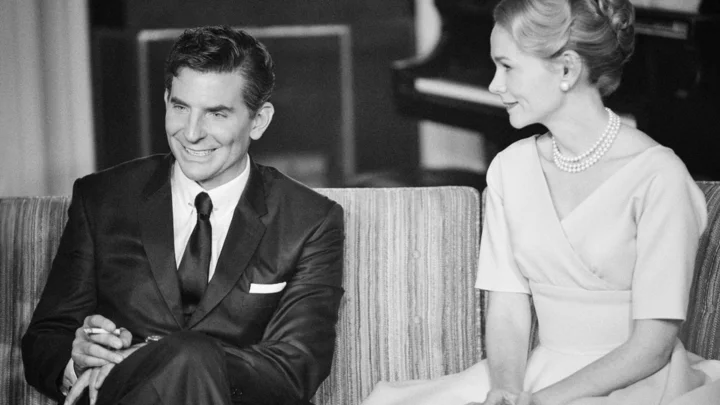Maestro, Bradley Cooper’s second outing behind the camera, is an enormous stylistic departure from his first, the 2018 remake of A Star is Born. However, what they have in common (apart from depicting the love lives of artists) is that they’re both good films that come ever so close to being great.
His sophomore effort is about the life of Leonard Bernstein, the famous New York composer and conductor, who Cooper also plays. While it traces his artistic journey, the film’s main focus is on Bernstein's marriage to Chilean-Costa Rican actress Felicia Montealegre (Carey Mulligan), from their rocky romance to their family life to Bernstein’s affair with several men over the years. Maestro begins, however, with an elderly Bernstein looking back on their time together after Montealegre’s death from cancer, framing the film’s events in the form of memory.
SEE ALSO: Is going to a movie during the WGA/SAG-AFTRA strike crossing the picket line?Maestro is a throwback to Hollywood's Golden Age
Credit: Jason McDonald/NetflixBernstein, though he's considered the first great American conductor, was also the composer behind a pair of landmark films: Elia Kazan's On The Waterfront, and Robert Wise and Jerome Robbins' West Side Story (he also wrote the music for the original stage production). While he was known more for theatrical and orchestral work, the lens through which Cooper approaches Bernstein is, understandably, cinematic, between borrowing elements of the aforementioned scores, and presenting a significant chunk of the movie in era-appropriate black and white and a 4:3 aspect ratio, since the earliest events it traces unfolds in the 1940s.
However, Cooper doesn’t just scrape the surface of Hollywood’s Golden Age. Rather, he takes inspiration from its tone and classical framing. When Bernstein and Montealegre first meet, they exchange overlapping, rapid-fire quips right out of a screwball comedy, and while Cooper and Mulligan mumble much of their lively dialogue in these scenes, understanding their words isn’t nearly as important as understanding the connection they create.
Credit: Jason McDonald/NetflixThis section of the film, which charts Bernstein and Montealegre’s early relationship, is exuberant and energetic. The camera bursts to life and swoops through space during both romantic excitement and professional success (two ideas which become instantly entwined, portending things to come). Re-teaming once more with cinematographer Matthew Libatique, Cooper creates alluring visual tableaus composed of light, shadow, and silhouette, and for much of the film’s extended first act, nearly every moment exudes spellbinding passion.
Maestro verges on the vivacious formalism of early Hollywood musicals, and at times, even breaks into abstract dance sequences to silently externalize not only the butterflies of the couple’s courtship, but the potential hurdles that lie before them. At one point, while showing Montealegre an early version of his sailor ballet Fancy Free (the eventual basis for On The Town), numerous dancers fill the stage and, in a dreamlike moment, Bernstein is whisked away by the show’s iconic trio of sailors as a dejected Montealegre looks on, understanding that both his work and other queer men will always have Bernstein’s attention.
Bradley Cooper should just direct a musical already
Credit: Jason McDonald/NetflixIt's a shame that Cooper hasn’t made a musical yet, because he’s so well-suited to the form and its dynamic symbolism. Maestro allows him to channel a more classical filmmaking approach, one of calculated framing and movements that feel organic when they’re used to punctuate emotional highs — rather than his free-wheeling, hand-held style on A Star Is Born, which often felt scattered, and left even that film’s most powerful performances feeling disconnected from one another.
These black and white segments, which channel both the cinematic verbiage and the dreamlike glitz and glamor of the time, are where the film feels most perfect and pristine, albeit with cracks that slowly begin to show each time Bernstein is around men with whom he’s involved. The specter of homosexuality threatening a traditional Hollywood star-couple is undoubtedly regressive on its surface, but in the context of the narrative — a cinematic memory as recalled by Bernstein — it’s a retrospective on which aspects of his life are considered acceptable to show off to the world in operatic terms, and which parts of him are too subversive for such a thing. There’s never a verbal conversation about why Bernstein can’t be seen dating men in public (of course, the time period is self-explanatory), but there are several silent exchanges that elucidate the feelings of betrayal therein.
Credit: Jason McDonald/NetflixThe film’s Golden Age throwback is perfectly in line with Bernstein and Montealegre’s extended honeymoon phase, but with a few liberties that suit the narrative. Perhaps rightly, it omits their broken engagement during this period and the fate of a relationship Montealegre had in the interim — that is, until it comes up later in the movie during an argument, when their marriage is far less amiable. Once the film skips forward to the late '50s and early '60s, it enters its color phase (while still retaining its square-ish shape), and the alluring, old Hollywood sheen finally wears off. Unfortunately, there isn’t much by way of relevant pastiche that Cooper employs from this point on, leaving little room for the kind of visual flourishes and throwbacks that made its first act sing.
One on hand, a more grounded, realistic approach does also align with the cracks in the couple’s dynamic being slowly revealed. However, Cooper’s subsequent filmmaking decisions tends to feel emotionally noncommittal, even when the actors are putting on an absolute banger of a show.
‘Maestro’s great performances are imperfectly framed
Credit: Jason McDonald/NetflixThere are a handful of moments during the color scenes where Cooper makes some stunning directorial decisions that completely depart from his previous work. Perhaps the most powerful scene in A Star Is Born features Cooper’s Jack and Lady Gaga’s Ally engaged in a nasty verbal argument in the bathroom, during which Cooper trains his floating camera on each of their close ups, capturing their most raw and painful moments with uncomfortable proximity.
Bernstein and Montealegre fight similarly, and both actors’ performances are just as impassioned, but this time around, Cooper keeps the camera at a distance, capturing both characters in a wide, unmoving master shot. It’s befitting of a memory from which Bernstein likely wants to distance himself, and the environment in which the biggest of these arguments takes place also informs it in ironic ways (keep your eye on the nearby window for a hearty laugh).
A major reason this works, however, is Cooper and Mulligan’s physical performances. The scene lets their body language and the outline of their form do all the talking. Both actors are fully attuned to their characters’ predicaments and points of view, and now that the overlap of their dialogue is more contentious than flirtatious, they’re forced to perform a thespian highwire act in which neither Bernstein nor Montealegre wants the other to be heard, but both Cooper and Mulligan must ensure that their scene partner is. It's quite a sight to behold, both at a remove — as an exercise in theatrical performance and the careful exchange of energy — and as a dramatic centerpiece of the film itself.
Credit: Jason McDonald/NetflixThese are the kinds of lived-in performances that are sure to show up during award season, especially since the Academy loves showy acting complimented by physical transformations. Cooper’s exaggerated fake nose, mixed with his H. Jon Benjamin-like delivery (the voice of Archer and Bob Belcher) gives him a cartoonish, caricatured quality. The enormous size of the prosthesis leaves his eyes feeling overtly close together, but he translates this into a boyish energy that feels just right for the spirited first act, during which his mouth tends to hang open in a near-permanent smile.
However, what appears to be largely missing from Maestro — something A Star Is Born contained in spades — is the vitality and viscerality of these performances in close up. This is through no fault of Mulligan’s, and certainly no fault of Cooper’s as an actor, but what he gains in dramatic and subtextual clarity by employing a more classical directing approach, he loses in spontaneity. His formalist approach becomes too rigid — too restricting.
Credit: Jason McDonald/NetflixThe reason A Star Is Born felt so dramatically engaging, even if it often struggled to coherently string a scene together, was that it felt laced with explosive unpredictability, as if the actors’ most vulnerable moments were being created (by the actors) and investigated (by the camera) at exactly the same time. This is something at which Mulligan excels; take, for instance, her performance in Paul Dano’s Wildlife, which feels almost entirely strung together from moments of deep, intimate thought after Dano had called “cut,” but the camera had kept rolling a few seconds longer. Maestro, on the other hand, is a much more segmented film in this regard.
With the exception of the aforementioned argument (and one other unbroken take of Bernstein conducting at length), few scenes feel as though they’ve been meticulously mined for their full dramatic potential. The film sets a high bar by opening with Bernstein’s quote from a Harvard lecture in 1976: "A work of art does not answer questions, it provokes them; and its essential meaning is in the tension between contradictory answers." However, little Maestro lives up to these lofty expectations.
Bernstein’s contradictions in the film are limited to his physical desires, and the camera rarely probes him for deeper complications. Montealegre, similarly, is defined mostly by her proximity to Bernstein, and while Mulligan makes a meal out of it — she wears the character’s longing and insecurities in every expression and movement — there’s little sense of Montealegre’s perspective either, or of the internal forces that might be pulling her between Bernstein and, well… not Bernstein. In what has unfortunately become typical of Cooper’s directing, the picture is powerful but incomplete.
Credit: Jason McDonald/NetflixCompared to A Star Is Born, the pieces of Maestro all fit neatly together, but this comes at a cost. The way Cooper approaches the couple’s reconciliation is visually awe-inspiring — a fluid moment of dialogue-free, music-heavy cinematic bliss that builds to a rousing crescendo — but despite working as an individual scene, it feels largely un-earned in the story’s larger purview. Chunks of the movie feel missing, and not just because it omits several key aspects of the characters’ lives (like relegating Bernstein’s Jewish identity to a few passing lines, or entirely skipping Montealegre’s anti-war activism). Rather, what it seems to lack is the dramatic rigor that would make its most operatic and emotional moments feel truly cathartic.
Despite the tragedies that befall them, too much comes too easily to the characters in Maestro — like the aforementioned reunion — because the most difficult and agonizing parts of their relationship, and of the actors’ dramatic processes, appear to have been left on the cutting room floor. That is, if they were ever conceived of in the first place.
Maestro hits select theaters Nov. 22 and is streaming on Netflix Dec. 20.









